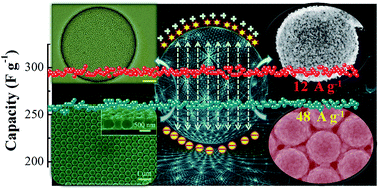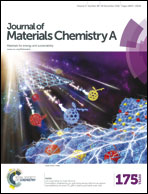Monolayer titanium carbide hollow sphere arrays formed via an atomic layer deposition assisted method and their excellent high-temperature supercapacitor performance†
Abstract
The directed construction of metal carbide arrays with a precise size and specific morphology still remains a great challenge. Herein we report a powerful atomic layer deposition (ALD)-assisted template synthesis strategy for the preparation of monolayer titanium carbide (TiC) hollow sphere arrays on a conductive substrate. Attractive properties, including a porous hollow structure and high electrical conductivity, have been achieved with the TiC hollow sphere arrays. When they are characterized as the electrodes of high-temperature (65 °C) organic supercapacitors, impressive performance including high capacitance, superior long-term cycle life (98% retention after 75 000 cycles) and good high-rate ability are demonstrated. Fast reaction kinetics and a quick response time for ion transportation are also proven for the TiC hollow sphere arrays. It is anticipated that our electrode design strategy may trigger new enthusiasm for advanced metal carbides for energy storage and electro-catalysis.


 Please wait while we load your content...
Please wait while we load your content...